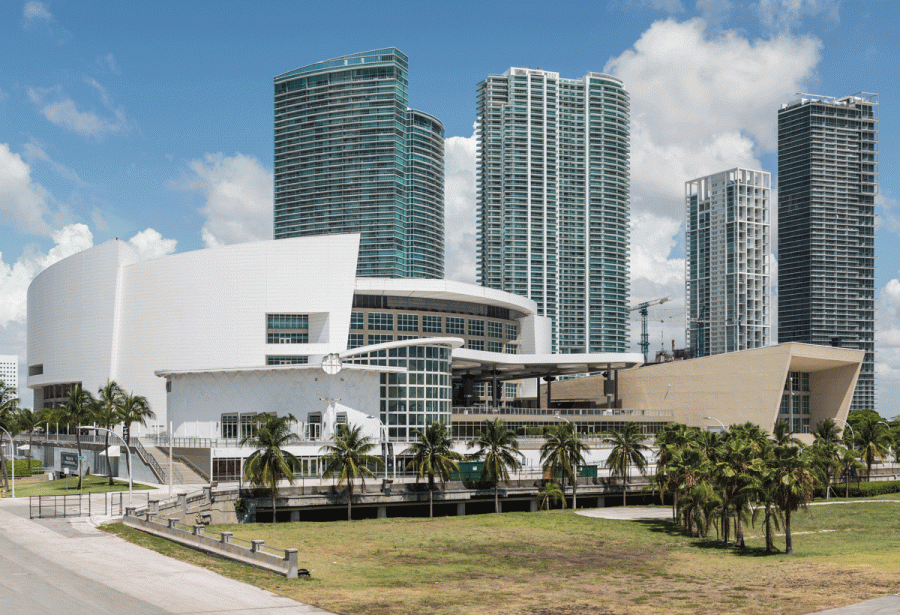Beyond the Bison: The case for moving American sports stadiums downtown
February 1, 2018
Famed American musician Jimmy Buffett once said, “We don’t have big old Gothic cathedrals like they do in Europe. But we got baseball parks.”
American sports stadiums are like cathedrals to the most loyal of fans. A major part of attending a sporting event is receiving the full fan experience; stadium accessibility, parking, the surrounding neighborhoods, and the amenities offered all contribute heavily to this experience.
Modern sports stadiums are construction mega-projects and can only be afforded by the largest corporations, wealthiest individuals, and the government. Taxpayers in Cobb County, Ga. kicked in more than $400 million of the $650 million total for the brand new SunTrust Park that opened in 2017, home of the Atlanta Braves major league baseball team. The AT&T Stadium in Arlington, Texas, home to the Dallas Cowboys of the NFL, cost a whopping $1.2 billion to build, with the taxpayers of Arlington contributing $325 million and team owner Jerry Jones paying the rest of the cost. Owners, however, tend to be less generous than Jerry Jones when it comes to paying out of their own pockets for stadium construction expenses. Publicly financed stadiums are typically the norm, but not without voices of complaints. Many feel that these stadiums serve as a symbol for irresponsible spending and skewed priorities.
Recently, a new trend has developed, with sports franchises moving from the sports complexes of the suburbs to the downtown areas of their respective cities. Driven in part by the recent urban American renaissance, the downtown areas of over a dozen cities are being transformed, as new arenas enter, prompting massive redevelopment.
The Golden 1 Center in Sacramento, Calif. for example, has been a success story for both the Sacramento Kings, who now get to keep their NBA franchise in Sacramento, and for the Sacramento economy. Vivek Ranadivé is the owner of the Kings franchise. He formed a partnership three years ago with the city, promising to transform a downtown mall into a newly opened arena along with a 1-million square foot commons.
The tremendous economic success of building Sacramento’s new stadium downtown is clear. Fifteen months after the opening of the Golden 1 Center, the streets of downtown Sacramento are full of life. According to the Downtown Sacramento Partnership, a city economic development group, the number of downtown jobs saw a 38 percent increase. The same economic development group reported the opening of 27 new stores within the past year, with 23 stores scheduled to open in the next calendar year.
“Four years ago, this place was dead,” Ranadivé said. “You could have thrown a bowling ball and it wouldn’t have hit a soul.”
The Sacramento Kings franchise is only one example of the trend of centering new sports arenas around the redevelopment of residential, retail and office space in the city. Many more sports franchises have begun to consider moving downtown, and appropriately so.
19 of the 30 MLB franchises currently have home ballparks in urban locations. The Kansas City Royals could very well be the next franchise to move downtown. Kauffman Stadium has been home to the Royals since 1973, and the current lease runs through 2031. It seems possible, though, that the 2015 World Series Champions may play home games somewhere else before then. Royals have already discussed four potential sites with the city of Kansas City, Mo. for a possible move.
A downtown stadium provides the ultimate fan experience. Downtown stadiums often offer more dining options for fans before and after the game as well. The motivation for a sports franchise to relocate downtown can come from an effort to increase attendance. It might partially explain why, on average, the Tampa Bay Rays fill only about 35 percent of Tropicana Field per game, located right outside Tampa in St. Petersburg, Fla. while the Tampa Bay Lightning, who play downtown at Amalie Arena, sell out almost every game.
Last May, I attended a San Francisco Giants game while visiting a close friend. AT&T Park has been home to the San Francisco Giants since 2000 and is centrally located in the financial district of San Francisco. Its location within the city made my trip to the stadium effortless. Before the game, I enjoyed playing ping-pong while snacking on pulled pork sliders at a chic ping-pong bar named SPiN, located conveniently across the street from the stadium. From there I enjoyed an ice cream cone while walking around one of the piers overlooking the bay. Once at the game, I found the views from inside the stadium are enough to draw people to attend Giants games. If this ballpark was set outside of the city, I would not be getting the same fan experience.
Sports franchises will continue to be open to having conversations about moving downtown, as long as they feel it is worth it in the face of the challenges posed from working with local governments and the general public in building and maintaining these stadiums.























Alexander • Feb 2, 2018 at 4:36 pm
I agree Patrick Dempsey, having a stadium in a city is great for attendance as public transportation makes it so convenient to get to a stadium.